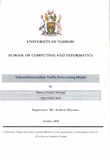| dc.contributor.author | Maina, Charles M | |
| dc.date.accessioned | 2013-03-01T14:03:10Z | |
| dc.date.issued | 2011 | |
| dc.identifier.citation | Masters of science in computer science | en |
| dc.identifier.uri | http://erepository.uonbi.ac.ke:8080/xmlui/handle/123456789/13114 | |
| dc.description.abstract | A problem of limited resources at the International Switch existed and this led to congestion.
Congestion occurred when the call load exceeded the capacity of available routes or trunks, or
of common control equipment for example, call registers that temporarily store call data while
the call is being processed. Congestion also occurred when the call load could not be handled in
available real time. There were some identified calls drop rates of about 15% due to limited
Bandwidth resources at the Switch and this posed challenges oflost revenue.
Telecommunications system designers have studied the problem of system resource congestion
for years. These same problems were evident at the switch where International Traffic got
transited from all local operators to International operators.
We discuss the results of the study done on forecasting the Telecommunication Traffic from
Kenya local operators to the International destinations through a common gateway, the
International Switch (IGW). The idea was to determine the volumes of traffic each operator
transit through the International Switch and to pick the operator giving maximum revenue to the
company and to optimize the resources available at the International Switch based on the
outcome of the prediction scenarios.
Success on data collection eventually led to the formulation of data cycles each cycle containing
7-days. The derived seasonal indices of the days in the cycle were found to be considerably
applicable in the computations of the trend and seasonal forecasts. Forecasting was determined
by developing a Linear Regression model and then fitting an observed dataset of four months
(Jan-April) into the model with two independent variables namely duration and period being
used as the key elements. Time series were used due to their intelligent nature of learning from
additional data. An Artificial neural network forecasting model was also developed. The system
could forecast the operator's traffic volumes based on the past historical trends and provide
decision-making for the Carrier Connect team to implement.
The research reveals that in making predictions regarding Telecommunication Traffic, a
Prediction Model can be developed and be implemented whose objective is to predict traffic
volumes. The results also reveal that the Linear Regression model shows better optimal results
than the Neural Network system in the Forecasting of Telecommunication traffic | en |
| dc.language.iso | en | en |
| dc.publisher | University of Nairobi | en |
| dc.subject | Telecommunication | en |
| dc.subject | Traffic | en |
| dc.subject | Forecasting | en |
| dc.subject | Model | en |
| dc.title | Telecommunication Traffic Forecasting Model | en |
| dc.type | Thesis | en |
| local.embargo.terms | 6 months | en |
| local.publisher | School of Computing and Informatics | en |

